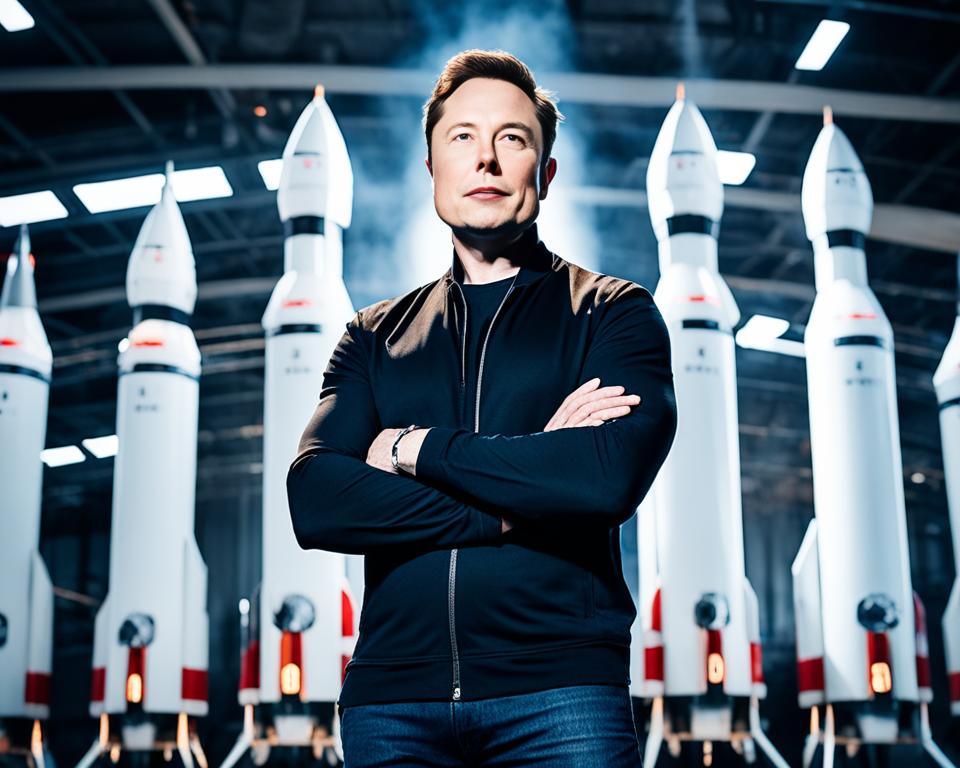Elon Musk, the founder of SpaceX and CEO of Tesla Motors, is renowned for his exceptional leadership style that encompasses innovation, ambition, and an unwavering commitment to excellence. In this article, we will delve into the characteristics of Elon Musk’s leadership style, explore his innovative leadership traits, and examine the management practices that have propelled him to success in shaping the future of technology. By gaining insights into Elon Musk’s leadership style, business owners and executives can glean valuable lessons on effective techniques and strategies for driving innovation.
Key Takeaways
- Elon Musk’s leadership style combines innovation, ambition, and a commitment to excellence.
- Musk’s innovative leadership traits inspire and motivate others to join him in achieving his vision.
- While primarily transformational, Musk’s leadership style also exhibits elements of autocratic and transactional leadership.
- Musk’s ability to learn from failure and embrace resilience is a key aspect of his leadership style.
- Musk emphasizes problem-solving and innovative thinking to drive creativity and foster innovation within teams.
Table of Contents
Transformational Leadership of Elon Musk
Elon Musk’s leadership style can be categorized as transformational leadership. He embodies the qualities of a visionary and a changemaker, constantly pushing the boundaries of innovation and achieving large-scale goals. Musk’s leadership is driven by his innovative thinking, analytical mindset, problem-solving abilities, strategic planning, and effective execution.
Similar to other renowned leaders like Steve Jobs and Jeff Bezos, Musk doesn’t wait for the world to change; instead, he takes proactive steps to bring about the change he envisions. His transformational leadership style inspires and motivates others to join him in his pursuit of ambitious goals, transforming industries and shaping the future of technology.
Musk’s strength in innovative thinking allows him to identify unique solutions to complex problems, disrupting traditional industries and revolutionizing the status quo. His analytical mindset enables him to analyze situations objectively, evaluate risks, and make calculated decisions that drive progress and growth.
Moreover, Musk’s problem-solving abilities and strategic planning skills enable him to navigate challenges and uncertainties effectively. He embraces a hands-on approach, diving deep into details, understanding the intricacies of each project, and formulating comprehensive action plans to achieve desired outcomes. This meticulous planning and strategic execution contribute to his success in realizing groundbreaking initiatives.
By embodying transformational leadership, Elon Musk encourages his team members to think beyond conventional boundaries and pursue innovation fearlessly. He creates an environment that nurtures creativity, collaboration, and continual improvement—the ideal breeding ground for groundbreaking ideas and disruptive technologies.
| Key Traits of Elon Musk’s Transformational Leadership Style |
|---|
| Innovative thinking |
| Analysis |
| Problem-solving |
| Planning |
| Strategy execution |
| Strategic vision |
Elon Musk’s transformational leadership style serves as an inspiration for aspiring entrepreneurs and leaders, highlighting the importance of thinking big, embracing innovation, and executing strategies with precision. Through his exceptional leadership, he has paved the way for future generations of changemakers.
Autocratic and Transactional Aspects of Elon Musk’s Leadership Style
While Elon Musk’s leadership style is primarily transformational, he also exhibits elements of autocratic and transactional leadership. His strong desire for sole authority and making decisions without much consultation aligns with an autocratic leadership style. Additionally, his focus on work as a business transaction and his tendency to be a control freak reflect transactional leadership traits.
It’s important to note that these aspects of Musk’s leadership style can lead to organizational problems if left unchecked. This autocratic approach may hinder collaboration and employee engagement, creating a top-down decision-making process that limits creativity and innovation within the organization. Likewise, the transactional nature of leadership can create a productivity-driven culture that may prioritize short-term goals over long-term strategic vision.
Elon Musk as an Autocratic Leader
As an autocratic leader, Elon Musk exhibits control over decision-making, often relying on his own expertise and instincts. He sets clear expectations, directives, and specific instructions, expecting them to be followed without question. This leadership approach can be seen in his role as the CEO of SpaceX and Tesla, where he plays a crucial part in key decisions and major company directions.
Elon Musk as a Transactional Leader
In addition to being an autocratic leader, Elon Musk displays transactional leadership tendencies. He views work as a series of business transactions, emphasizing a results-oriented approach and setting performance expectations. This transactional style can be seen in his management practices, such as setting ambitious goals, closely monitoring progress, and offering rewards for meeting specific targets. Musk’s control freak tendencies reinforce his transactional style, seeking to ensure that tasks are executed precisely and efficiently.
While Elon Musk’s autocratic and transactional aspects of leadership contribute to his success in driving innovation and achieving ambitious goals, it’s important to recognize their potential drawbacks and address any organizational problems that may arise. Creating a balanced leadership approach that incorporates elements of collaborative decision-making, employee empowerment, and fostering a culture of innovation can help mitigate the negative impacts of these leadership styles.
| Leadership Style | Key Traits |
|---|---|
| Autocratic Leadership |
|
| Transactional Leadership |
|
Lessons from Failure and Resilience in Elon Musk’s Leadership Style
Elon Musk’s leadership style is a testament to his ability to learn from failure and demonstrate remarkable resilience. When faced with near-failure situations with Tesla and SpaceX, Musk delivered motivating speeches to his team, emphasizing the importance of perseverance and the need to reevaluate and improve strategies. Through his leadership, Musk encourages businesses to embrace failure as an opportunity for growth and progress.
Musk understands that failure is an inevitable part of the journey towards success. Rather than fearing failure, he sees it as a stepping stone to innovation. He encourages businesses to reevaluate and improve their strategies based on the lessons learned from failure. By actively reevaluating and adapting their approaches, organizations can continuously improve and stay ahead in the rapidly changing landscape of technology and innovation.
Overcoming the Fear of Failure
An important aspect of Elon Musk’s leadership style is his ability to overcome the fear of failure. He believes that this fear, if left unaddressed, can hinder progress and hinder the potential for innovation. Musk encourages individuals and organizations to confront and overcome their fear of failure by embracing it as a driving force for growth and creativity.
In his motivating speeches, Musk emphasizes the importance of communicating the purpose of changes and the silver lining that failure can bring. By fostering a culture that destigmatizes failure, businesses can create an environment where employees feel encouraged to take risks and think outside the box.
Problem-Solving and Innovative Thinking in Elon Musk’s Leadership Style
Elon Musk’s leadership style is characterized by a strong emphasis on problem-solving and innovative thinking. He encourages his team to approach challenges from different perspectives, question assumptions, and use creative solutions to arrive at innovative outcomes. Musk’s curiosity and willingness to explore uncharted territories drive his team to push boundaries and find new ways to solve complex problems.
One problem-solving technique that Musk advocates for is the 5 Whys method. This method involves repeatedly asking “why” until the root cause of a problem is uncovered. By systematically questioning the underlying issues, Musk believes that teams can gain deeper insights and develop more effective solutions.
In addition to the 5 Whys method, Musk emphasizes the importance of research and continuous learning. He encourages extensive research and consults with experts to gain a deep understanding of problems and potential solutions. This thorough approach enables his team to make informed decisions and drive innovation.
Another key aspect of Musk’s problem-solving approach is reverse engineering. By deconstructing existing products or processes, Musk’s teams can understand how things work and identify areas for improvement or innovation. This reverse engineering approach allows for creative problem-solving and the development of innovative solutions.
Musk doesn’t stop at ideation and problem-solving; he takes an action-oriented approach to drive implementation. He sets ambitious goals, creates a clear action plan, and ensures that tasks are assigned and executed efficiently. This hands-on approach to problem-solving and execution inspires his team to take ownership of their work and continuously strive for excellence.
Innovative Thinking in Practice: Example
To illustrate Elon Musk’s innovative thinking in practice, let’s examine the development of the Tesla Model S. When designing this electric vehicle, Musk and his team looked beyond conventional car design and took an entirely innovative approach. They leveraged advanced battery technology to create a sleek, high-performance electric car with an impressive range.
| Traditional Car Design | Tesla Model S |
|---|---|
| Internal combustion engine | Electric motor |
| Gasoline-powered | Battery-powered |
| Mechanical transmission | Single-speed transmission |
| Internal combustion engine noise | Silent operation |
| Limited range | Long electric range |
This revolutionary approach to car design has disrupted the automotive industry, demonstrating the power of Musk’s innovative thinking and problem-solving abilities. By challenging the status quo and adopting a curiosity-driven mindset, Musk continues to revolutionize industries and push the boundaries of innovation.
Conclusion
In conclusion, Elon Musk’s leadership style embodies the traits of thinking big, fostering innovation, staying hands-on, prioritizing learning and adaptability, leading with passion and purpose, and empowering his staff. His unique blend of leadership styles, including transformational, autocratic, democratic, and laissez-faire, has enabled him to achieve remarkable success in his ventures.
Business owners and executives can learn valuable lessons from Elon Musk’s leadership style to inspire and motivate their own teams and ultimately drive innovation in their organizations. Musk’s ability to think big pushes the boundaries of what is possible and encourages others to do the same.
His hands-on approach ensures that he is actively involved in the day-to-day operations of his companies, leading by example and setting high standards for excellence. Musk’s emphasis on learning and adaptability fosters a culture of continuous improvement and encourages his team to embrace change and challenges head-on.
Moreover, Elon Musk’s leadership is driven by a strong sense of purpose and passion. He has a clear vision for the future and communicates this vision to his team, inspiring them to work towards common goals. By empowering his staff, Musk creates an environment of trust and autonomy, where individuals are encouraged to bring their unique perspectives and ideas to the table.


